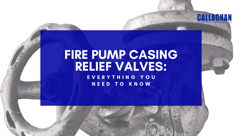When choosing and installing fire pump casing relief valves, make sure you do your homework. To learn more about casing relief pumps, feel free to read on.
ensure the smooth operation of fire protection devices. The fire pump's performance has a direct impact on the performance of the entire fire protection system, so it is crucial to ensure the pump is functioning correctly.
Fire Pump Casing Relief Valves
Fire pump casing relief valves are required for both diesel and electric fire pump models for abnormal conditions like engine over-speeding or excess suction supply. Also, they are required on VFDs when the bypass operation exceeds a system design. These valves should not be used as pressure maintenance devices to limit water pressure.The main role of the pump casing relief valve is to automatically prevent controlled pumps from overheating. This happens when they are being operated at shut-off or no discharge. However, the valve is not required for those pumps for which the water for engine cooling is taken from the pump discharge.
Why Do You Need a Main Relief Valve on Fire Pump Diesel Engines?
When it comes to diesel fire pumps, one of the most common misconceptions is that you are no longer required to have a main relief valve. It is also incorrectly referred to as a relief valve in some scenarios. To comply with the NFPA 202 (National Fire Protection Association), you will need to determine two different things.- The performance of the diesel fire pump being considered
- The maximum static suction pressure feeding the pump
Sizing and Location of Main Relief Valves
The main relief valve shall be sized hydraulically to discharge sufficient water to prevent the pump discharge pressure. It should be adjusted for elevation to prevent it from exceeding the pressure rating of the system components. In case the discharge pipe employs more than one elbow, you will need to use the next largest pipe size.In terms of its setting, the casing relief valve should be set at the point just below the lowest expected suction pressure, plus the shutoff pressure of the unit. It must be piped to drain. The location of the main relief valve shall be somewhere between the pump and the discharge check valve.
Key types of relief pumps include listed spring-loaded and pilot-operated diaphragm-type valves. In addition to that, the relief valve should discharge into an open pipe or into a funnel secured to the outlet of the valve. Also, the water discharge from the relief valve should be readily visible.
Installation of Main Relief Valves
Make sure you don’t install a shutoff valve in the relief valve supply or discharge piping. Relief valve discharge piping should not be combined with the discharge from other relief valves. Also, the discharge piping from multiple relief valves won’t have to be combined with fire pump test piping.If you would like to learn more about fire pump diesel engines or casing relief valves, feel free to get in touch with us.

No comments:
Post a Comment